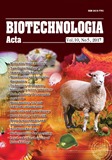ISSN 410-7751 (Print)
ISSN 2410-776X (on-line)

"Biotechnologia Acta" V. 10, No 5, 2017
https://doi.org/10.15407/biotech10.05.063
Р. 63-71, Bibliography 21, English
Universal Decimal Classification: 620.3+646.655:581.1
1National University of Life and Environmental Sciences of Ukraine, Kyiv
2Institute for Evolutionary Ecology of the National Academy of Sciences of Ukraine, Kyiv
3Zabolotny Institute of Microbiology and Virology of the National Academy of Sciences of Ukraine, Kyiv
The aim of this work was to study the effect of cerium dioxide nanoparticles on the germination of Scots pine (Pinus sylvestris) seeds and the subsequent physiological changes in plastid pigments and phenolic compounds accumulation in the seedlings tissues. Brief soaking of pine seeds in solutions of cerium dioxide nanoparticles (2-4 nm) increases the germinating power and seed germination by 1.3 times. In pine seedlings, germinated from six month old seeds, reduction in chlorophyll b, phenols and phenylalanine content is observed in 14 days after treatment. Simultaneously, concentration of carotenoids and flavonoids increased. This indicates the overall decrease in phenylpropanoid synthesis. Hence, it is reasonable to assume that cerium dioxide nanoparticles, having entered the cells of Scots pine seeds, are engaged in the regulation of phenol and terpenoid synthesis in seedlings, which greatly affects the intensity of their growth and development.
Key words: Scots pine (Pinus sylvestris L.), cerium dioxide nanoparticles, germination of seeds, phenols, flavonoids, carotenoids.
© Palladin Institute of Biochemistry of the National Academy of Sciences of Ukraine, 2017
References
1. Melnichuk M. D., Pinchuk A. P., Lihanov A. F., Maurer V. M., Klyuvadenko A. A. Influence of preparation of planting material on adaptive potential of pine seedlings (Pinus sylvestris L.). Bioresursy i pryrodokorystuvannia. 2013, 5(5–6), 92–98. (In Ukrainian).
2. Savchenko Yu. M., Grigoryuk I. P., LIhanov A. F., PInchuk A. P. The protective effect of the derivative N-oxide-2-methylpyridine on temperature stress in germination of pine seeds Zbalansovane pryrodokorystuvannia. 2016, 2, 83–88. (In Ukrainian).
3. Babenko L. P., Zholobak N. M., Shcherbakov A. B., Voychuk S. I., Lazarenko L. M., Spivak M. Ya. Antibacterial activity of cerium colloids against opportunistic microorganisms in vitro. Microbiol. J. 2012, 74(3), 54–63.
4. Minchenko D. O., Spivak M. Y., Herasymenko R. M., Ivanov V. K., Tretyakov Y. D., Minchenko O. H. Effect of cerium dioxide nanoparticles on the expression of selected growth and
transcription factors in human astrocytes. Mat.-wiss. u. Werkstofftech. 2013, 44(2–3), 156–160. doi: 10.1002/mawe.201300091.
5. Liu D. The effects of cerium on the growth and some antioxidant metabolisms in rice seedlings.
Environ. Sci. Pollut. Res. 2012, 19(8), 3282–3291
6. Garcia A., Espinosa R., Delgado L., Casals E., Gonzаlez E., Puntes V., Barata C., Font X., Sаnchez A. Acute toxicity of cerium oxide, titanium oxide and iron oxide nanoparticles using standardized tests. Desalination. 2011, 269, 136–141.
7. Corral-Diaz B., Peralta-Videa J. R., Alvarez-Parrilla E., Rodrigo-Garc?a J., Isabel Morales M., Osuna-Avila P., Niu G., Hernandez-Viezcas J. A., Gardea-Torresdey J. L. Cerium oxide nanoparticles alter the antioxidant capacity but do notimpact tuber ionome in Raphanus sativus (L.).
Plant Physiol. Biochem. 2014, V. 84, P. 277–285
https://doi.org/10.1016/j.plaphy.2014.09.018.
8. Wang Q., Ma X., Zhang W., Peia H., Chen Y. The impact of cerium oxide nanoparticles on tomato (Solanum lycopersicum L.) and its implications for food safety. Metallomics. 2012, V. 4, P. 1105–1112. doi: 10.1039/C2MT20149F.
9. Zhang Z., He X., Zhang H., Ma Y., Zhang P., Ding Y., Zhao Y. Uptake and distribution of ceria nanoparticles in cucumber plants. Metallomics. 2011, 3(8), 816–822. doi: 10.1039/C1MT00049G.
10. Handbook of Food Analytical Che mistry: Pigments, Colorants, Flavors, Texture, and Bioactive Food Components. Ed. by E. Wrolstad. Pigments and Colorants. 2005, V. 4, P. 175–176.
11. Sibgatullina G. V., Haertdinova L. R., Gumerova E. A. Methods for determining the redox status of cultured plant cells. Kazan: Kazanskiy (Privolzhskiy) Federalnyy universitet. 2011, 61. (In Russian).
12. Heathcote J. G., Haworth C. The direct determination of amino acids on thin-layer chromatograms by densitometry. Biochem. J. 1969, 114, 667–668
https://doi.org/10.1042/bj1140667.
13. Scherbakov A. B., Ivanova O. S., Spivak N. Ya., Kozik V. V., Ivanov V. K. Synthesis and biomedical applications of nanodispersed cerium dioxide. Tomsk: Izd. Dom Tomskogo gos. un-ta. 2016, 476 p. (In Russian).
14. Gorshkova T. A. Plant cell wall as a dynamic system. Moskva: Nauka. 2007, 426 p. (In Russian).
15. Majumdar S., Peralta-Videaa J. R., Bandyopadhyay S., Castillo-Michel H., Hernan dez Viezcas J.-A., Sahi S., Gardea-Torresdey J. L. Exposure of cerium oxide nanoparticles to kidney bean shows disturbance in the plant defense mechanisms. J. Hazard. Mater. 2014, V. 278, P. 279–287
https://doi.org/10.1016/j.jhazmat.2014.06.009.
16. Wang Q., Ebbs S.D., Chenc Y., Ma X. Transgenerational impact of cerium oxide nanoparticles on tomato plants. Metallomics. 2013, V. 5, P. 753–759. doi: 10.1039/C3MT00033H
17. Rico C. M., Hong J., Morales M. I., Zhao L., Barrios A. C., Zhang J. Y., PeraltaVidea J. R.,
Gardea-Torresdey J. L. Effect of cerium oxide nanoparticles on rice: a study involving the antioxidant defense system and in vivo fluorescence imaging. Environ. Sci. Technol. 2013, V. 47, P. 5635–5642. doi: 10.1039/C3MT00033H
18. Zaprometov M. N. Phenolic compounds. Distribution, metabolism and function in plants. Moskva: Nauka, 1993, 272 p. (In Russian).
19. Vincent A., Inerbaev T. M., Babu S. Tuning Hydrated Nanoceria Surfaces: Experimental/Theoretical Investigations of Ion Exchange and Implications in Organic and Inorganic
Interactions. Langmuir. 2010, V. 26, P. 7188–7198. doi: 10.1021/la904285g
20. Diatloff E., Smith F.W., Asher C.J. Effects of lanthanum and cerium on the growth and mineral nutrition of corn and mungbean. Ann. Botan. 2008, V. 101, P. 971–982.
https://doi.org/10.1093/aob/mcn021
21. Kuchma M. H., Komanski C. B., Colon J., Teblum A., Masunov A., Alvarado B., Babu S., Seal S., Summy J., Baker C. H. Phosphate ester hydrolysis of biologically relevant molecules by cerium oxide nanoparticles. Nanomedicine. 2010, V. 6, P. 738–744.

